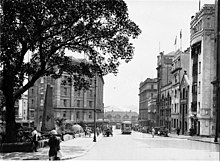Bridge Street, Sydney
Bridge Street | |
|---|---|
 | |
| Bridge Street looking east in August 2014 | |
| General information | |
| Type | Street |
| Length | 500 m (0.3 mi) |
| Major junctions | |
| West end | George Street |
| East end | Macquarie Street |
| Location(s) | |
| Suburb(s) | Sydney |
Bridge Street is a street in the CBD of Sydney, Australia. It runs east-west between George Street and Macquarie Street. It is in the local government area of the City of Sydney and the postcode is 2000. The street is 500 metres long.[1] It derived its name from a small bridge that used to cross the Tank Stream in the early days of the colony.[2]
History
Many years before Bridge Street was named, it was the site of Sydney's first Government House and was the abode of first Governor of New South Wales, Captain Arthur Phillip. After establishing the site of the settlement, a substantial "temporary" government house was located on the corner of what is now Bridge St and Phillip St in Sydney. It was built under the direction of James Bloodsworth, a convict builder responsible for the construction of most of the colony's buildings between 1788 and 1800.


This building, the first 'permanent' building in Sydney, was completed by 1789 using English bricks, native stone and a quantity of convict baked sandstock bricks from the Sydney region. After the initial completion the house was of two stories in height, contained six rooms and was the hub of the colony for 56 years. Eight successive governors complained of the living conditions within, each making improvements by adding their own extension. It was here on 4 June 1789, that Governor Phillip and his guests celebrated the birthday of King George III. In 1845 the entire complex was demolished to allow access and extend the street to Macquarie Street. The foundations of the house were exposed by archaeologists in 1983.[3] The site is now occupied by the Museum of Sydney, corner of Phillip and Bridge Street.[4]
In March 1899, workmen installing a telegraph tunnel discovered a copper plate wedged between two stones. It was later found that it was the foundation stone of the first Government House that was laid 15 May 1788. The plate is now displayed at the Museum of Sydney.[5]
Heritage buildings
Bridge Street has a number of significant buildings and sites. The following are listed on the Register of the National Estate.[6]


- Department of Lands building: this sandstone building was designed by the Colonial Architect, James Barnet, and built 1877-90. It is three storeys high and features a copper dome and a clock tower that is a distinctive feature in the area.
- Education Department Building: this is a six-storey, sandstone building designed by the government architect, George McRae.[7] It was built c. 1913 and features an inner structure of steel and reinforced concrete.
- Burns Philp Building: this three-storey, commercial building was built from 1898-1901. It was designed by Arthur Anderson of McCredie and Anderson in a Romanesque style. Like the other buildings, it was constructed predominantly of sandstone, with a combination of dressed stone and rough stone. The interior features elaborate cedar-work.
- Chief Secretary's Building: situated on the south corner of Bridge and Macquarie Streets, this building was designed by James Barnet and constructed c. 1878. It consists mainly of dressed sandstone, with later additions that were designed by the government architect, Walter Liberty Vernon.
- Former Premier's Office / Treasury Building: situated on the north corner of Bridge and Macquarie Streets, this is a two-storey sandstone building designed by Mortimer Lewis in a Classical Revival style and built c. 1849. A large extension was designed by Walter Liberty Vernon and built c. 1896. It has more recently been converted for hotel use.
- Macquarie Place: this historic site is situated on the north side of Bridge Street and was originally part of the first Government House. Governor Lachlan Macquarie intended it to be a significant public square but it was gradually whittled down over the years. It includes the obelisk designed by Francis Greenway and constructed in 1818; the bronze statue of Thomas Sutcliffe Mort erected in 1883; the cannon and anchor from HMS Sirius, the anchor having been placed on its pedestal in 1907; and the men's lavatory built in 1908, which features stucco and a glazed dome.
- Booth House: at 44 Bridge Street, on the corner of Young and Bridge Streets and situated on land which originally formed part of the gardens of First Government House. Built in 1938, this nine-storey building is an excellent and rare expression of the Functionalist style meeting a need for continuous natural light, through bands of windows, to accommodate wool-broking activities on completion. A stylised ram's head is etched into the red granite lintel above the entrance, pale green terracotta tiles remain under copper cladding the uprights between the windows. It is now an unusual mix of commercial and residential units.
-
Burns Philp building
-
Department of Education building
-
Statue of Thomas Mort, Macquarie Place
-
Chief Secretary's Building
See also
References
- ^ Gregory's Sydney Street Directory (2002), Map A
- ^ Sydney Architecture, John Haskell (UNSW Press) 1997, p.29
- ^ Historic Houses Trust of NSW, retrieved 2009-10-07
- ^ "The Governor of NSW: Government House". Parliament of New South Wales. NSW Government. Retrieved 10 December 2010.
- ^ Sharpe, Alan (2000). Picrtorial History City of Sydney. Alexandria, New South Wales: Kingsclear Books. p. 36. ISBN 0-908272-63-4.
{{cite book}}: Cite has empty unknown parameter:|coauthors=(help) - ^ The Heritage of Australia, Macmillan Publishers (1981), pp. 2/94,104,105
- ^ Sydney Architecture, p.29
External links
![]() Media related to Bridge Street, Sydney at Wikimedia Commons
Media related to Bridge Street, Sydney at Wikimedia Commons




